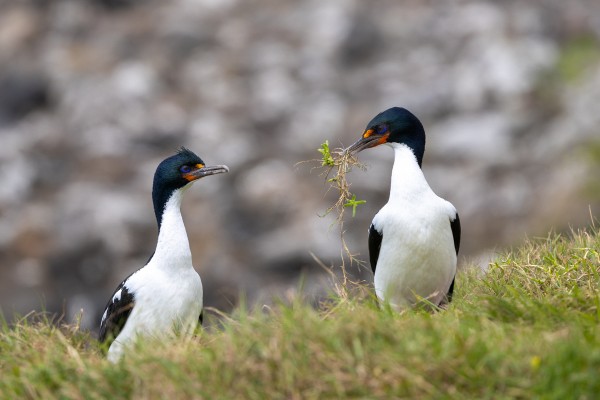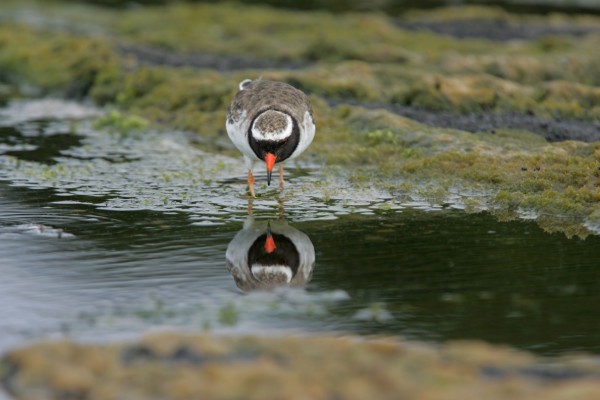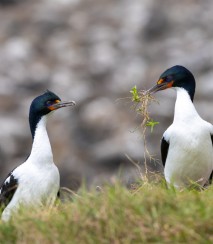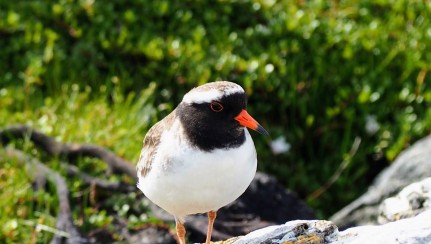
Species and environment
Shore birds
The Chathams provided the perfect habitat for a number of shorebirds to evolve and thrive. Unfortunately, as many of them nest on the ground, the introduction of mammalian predators along with other changes to their habitats put them at risk. They now also have to share the beach with species they didn't before.
There are eight shore bird species here, including three species of shag (two endemic and critically endangered) and the little penguin. Another penguin, the Chatham crested penguin, became extinct around 1500 CE.
How to help
When you're on the beach, don't forget you're sharing it! Keep your dogs on a leash, and during breeding season (usually spring and summer) remember that you might not see where nests are. Avoid riding horses or vehicles along the beach and tread carefully.
You can also get involved with trapping programmes, including backyard trapping. If you want some advice or to know what else is going on, just get in touch with us.
Here are some of the shorebirds of the Chathams.
Chatham Island oystercatcher
Chatham Island oystercatchers, or torea tai, are one of the endangered endemic birds that can be seen regularly on the main islands. An ongoing programme protecting these species helps make this a reality.

Chatham Island oystercatcher Image: Tamzin Henderson
The CI oystercatcher looks similar to other oystercatcher species, but is its own unique species. Another case of island giganticism, these birds are larger and stockier than oystercatchers found on mainland Aotearoa or around the world. And there are only around 350 of them.
They breed on rocky coastlines around our shores but they're very susceptible to predation and habitat loss. Their nests are scrapes in the sand, which helps provide camouflage from avian predators but also means it can be hard for beachgoers to see and avoid them. Where beaches are getting smaller due to habitat loss or increasing wave height, it's also very easy for their nests to be destroyed. Oystercatchers are also an easy target for predators like feral cats and dogs, and can be trampled by livestock.
Shags
There are two species of endemic shag: the Chatham Island shag and the Pitt Island shag. These are both coastal birds, often seen around headlands across the various islands and rocky islets. They are also both critically endangered.

Chatham Island shags at Manukau Point Image: Tamzin Henderson
The Chatham Island shag is large with a blue eye-ring, and orange colouring above and below the bill. It is the only large black and white shag and the only shag with pink feet. They tend to roost in flocks of 50 or more birds and breed in colonies, the largest of which are found in predator-free sites.
The Pitt Island shag is small, slender and grey, with lime-green colouring around its beak. It has a dark brown-grey back with feathers that have a small black spot, and its breast is pale grey. It breeds in smaller colonies of 3-20 pairs on coastal cliffs, islets and headlands. The facial colouring of both shag species is less striking outside of breeding season.
The third shag is the freshwater black shag, native to Aotearoa. This is the largest of the shag species and has dark plumage over all its body, except the face and a white patch on the flank during breeding time. They nest in small colonies, in flax clumps, and in tree tops. This species is less common than the two endemic shags, but exists widely on mainland Aotearoa.
Tūturuatu / tchuri wat’

Shore plover looking at reflection Image: Dave Boyle
They're distinctive birds, with dark faces, a brown cap, and orange beaks and feet. Their behaviour of chasing away predators and feigning injury to attract predators away from their nest is part of the reason they have become so endangered.
There are sustainable shore plover populations on Mangere/Maung ‘Re and Rangatira/Hokorereoro, with a hopeful pair showing up recently on Pitt Island. These birds are a ‘sentinel species’ on our nature reserve islands - because they are so susceptible to predators, they’re one of the first species that disappear if a rat or other predator gets onto these islands. Their numbers are checked regularly when conservation visits are made to the islands. And if they’re showing up in other places - like Pitt - that’s a sign predator control efforts are having an impact.
There’s only one self-sustaining population on the mainland (Waikawa Island, on the East Coast of the North Island) and there are three captive breeding facilities. The Chatham birds are crucial to the survival of the species, both because they’re doing so well here and because they can provide more genetic diversity as attempts are made to boost their population.






